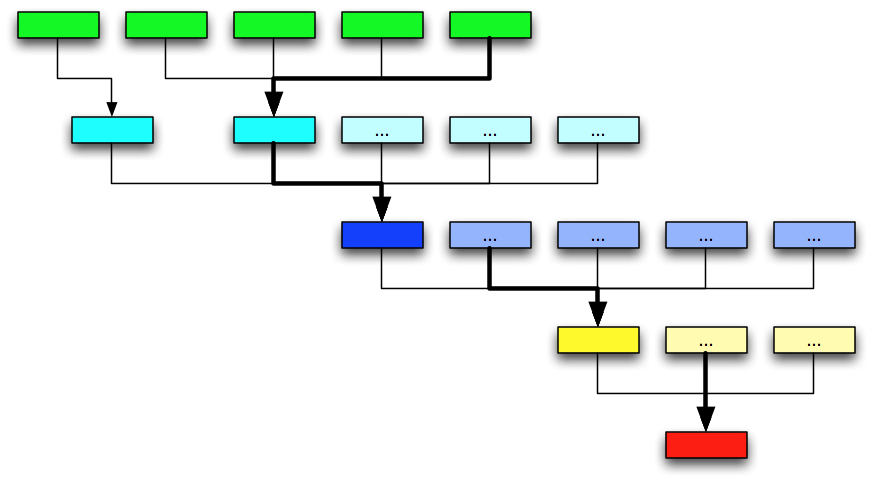Better Maps/Hierarchy
With an entirely self-referential system like outlined in Polygon Maps, we new kind of hierarchical system becomes easy. That is because we get a directed graph, which has all kinds of nifty features and all the math to handle it has already been invented.
Here is what our example regions in the lower-left look like in the graph:
The discoloured "..." boxes indicate other parts of the hierarchy where the details are not shown. The bold arrows indicate the "capital", meaning the two ends of the bold arrows are really the same place. We could collapse that graph at those points, but the hierarchical structure would be less clear if we do.
Contents
Inheritance
Let us ignore the places layer and begin at the estate layer, because this is the first political level.
Since all political entities are an estate, they are fundamentally the same. A realm is simple an estate that has several regions sworn to it.
This means all estates can pass rules, affecting themselves and anyone downwards of the hierarchy, through inheritance. "Rules" here is an abstract concept. Two examples of rulesets are diplomacy and taxes.
Diplomacy
Let us simplify diplomacy to a single value: Whether to attack or not attack someone else - war or peace.
Inheritance means that if the realm declares war on another realm, all duchies, baronies, regions and estates that are part of the realm will fight any duchies, baronies, regions and estates of the enemy realm. However, a rebellious region lord could override the realm-wide war with a setting of peace. In this case, units belonging to his region and estates within it, would not fight the units of the enemy realm (though, if the declaration of war is mutual, those may attack them, forcing a battle anyways).
This opens up an incredible amount of possibilities. Usually, the realm will follow realm-wide diplomacy settings. But the option is there not to. At the same time, more fine-grained diplomacy is possible. Imagine a realm declaring "war" on a single enemy region. The enemy realm - which has not declared war upon - now has several choices. It can send troops into the region to defend it (we ignore the details of alliance/aid for this example), or it could declare war against the attacking realm, escalating the conflict. This makes questions of "who is the aggressor" more interesting.
Most importantly, however, conflict within the same hierarchy becomes possible. Region A could declare war on region B of the same realm. No additional code or changes to code are required, since a region and a realm are just estates anyway.
Taxes
Actually, tariffs in this example. Taxes at the border.
Protectionism was a big thing in the middle ages, so let's simulate it. It is very, very simple: Every estate can set a border tax. The interesting thing is that a border can be several borders. Entering Kipple from outside could mean entering the estate of Keplerville and the region Keplerstan. So you would pay Keplerville and Keplerstan tariffs. Since goods will cross several borders in even a short trip, it is easy to see how tariffs alone make trade local, because transporting something over large distances can not possibly be profitable.
It also means income. If the border tax of Keplerville is 5%, and of Keplerstan 3%, and of Keplerstate 2% then entering Kipple from a foreign realm incurs a tax of 10%, half of which will go to the knight of Keplerville, 3% going to the lord of Keplerstan and 2% the the ruler or banker of Keplerstate. Everyone profits, well except the poor trader.
Whether to tax only on entering or also on leaving is an interesting point.
Complexity
All this hierarchical system sounds incredibly complicated, but the beauty of it all is that it can easily be computed. And since it can be computed, players don't have to bother with it. The game could tell them easily which taxes to expect at what borders during their journey. No real need for them to actually understand where they come from.
